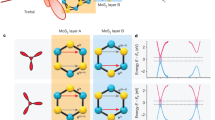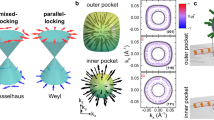Abstract
Direct-bandgap transition metal dichalcogenide monolayers are appealing candidates to construct atomic-scale spin-optical light sources owing to their valley-contrasting optical selection rules. Here we report on a spin-optical monolayer laser by incorporating a WS2 monolayer into a heterostructure microcavity supporting high-Q photonic spin-valley resonances. Inspired by the creation of valley pseudo-spins in monolayers, the spin-valley modes are generated from a photonic Rashba-type spin splitting of a bound state in the continuum, which gives rise to opposite spin-polarized ±K valleys due to emergent photonic spin–orbit interaction under inversion symmetry breaking. The Rashba monolayer laser shows intrinsic spin polarizations, high spatial and temporal coherence, and inherent symmetry-enabled robustness features, enabling valley coherence in the WS2 monolayer upon arbitrary pump polarizations at room temperature. Our monolayer-integrated spin-valley microcavities open avenues for further classical and non-classical coherent spin-optical light sources exploring both electron and photon spins.
This is a preview of subscription content, access via your institution
Access options
Access Nature and 54 other Nature Portfolio journals
Get Nature+, our best-value online-access subscription
$29.99 / 30 days
cancel any time
Subscribe to this journal
Receive 12 print issues and online access
$259.00 per year
only $21.58 per issue
Buy this article
- Purchase on Springer Link
- Instant access to full article PDF
Prices may be subject to local taxes which are calculated during checkout





Similar content being viewed by others
Data availability
The authors declare that the main data supporting the findings of this study are available within the article and its supplementary information. Extra data are available from the corresponding author upon reasonable request.
References
Shitrit, N. et al. Spin-optical metamaterial route to spin-controlled photonics. Science 340, 724–726 (2013).
Wu, S. et al. Monolayer semiconductor nanocavity lasers with ultralow thresholds. Nature 520, 69–72 (2015).
Ye, Y. et al. Monolayer excitonic laser. Nat. Photonics 9, 733–737 (2015).
Liu, Y. et al. Room temperature nanocavity laser with interlayer excitons in 2D heterostructures. Sci. Adv. 5, eaav4506 (2019).
Paik, E. Y. et al. Interlayer exciton laser of extended spatial coherence in atomically thin heterostructures. Nature 576, 80–84 (2019).
Stav, T. et al. Quantum entanglement of the spin and orbital angular momentum of photons using metamaterials. Science 361, 1101–1104 (2018).
Sederberg, S. et al. Vectorized optoelectronic control and metrology in a semiconductor. Nat. Photonics 14, 680–685 (2020).
Rashba, E. I. Properties of semiconductors with an extremum loop. 1. Cyclotron and combinational resonance in a magnetic field perpendicular to the plane of the loop. Sov. Phys. Solid State 2, 1109–1122 (1960).
Ishizaka, K. et al. Giant Rashba-type spin splitting in bulk BiTeI. Nat. Mater. 10, 521–526 (2011).
Dahan, N., Gorodetski, Y., Frischwasser, K., Kleiner, V. & Hasman, E. Geometric Doppler effect: spin-split dispersion of thermal radiation. Phys. Rev. Lett. 105, 136402 (2010).
Berry, M. V. Quantal phase factors accompanying adiabatic changes. Proc. R. Soc. Lond. A 392, 45–57 (1984).
Bomzon, Z., Biener, G., Kleiner, V. & Hasman, E. Space-variant Pancharatnam–Berry phase optical elements with computer-generated subwavelength gratings. Opt. Lett. 27, 1141–1143 (2002).
Xiao, D., Liu, G.-B., Feng, W., Xu, X. & Yao, W. Coupled spin and valley physics in monolayers of MoS2 and other group-VI dichalcogenides. Phys. Rev. Lett. 108, 196802 (2012).
Gong, S.-H., Alpeggiani, F., Sciacca, B., Garnett, E. C. & Kuipers, L. Nanoscale chiral valley-photon interface through optical spin-orbit coupling. Science 359, 443–447 (2018).
Sun, L. et al. Separation of valley excitons in a MoS2 monolayer using a subwavelength asymmetric groove array. Nat. Photonics 13, 180–184 (2019).
Rong, K. et al. Photonic Rashba effect from quantum emitters mediated by a Berry-phase defective photonic crystal. Nat. Nanotechnol. 15, 927–933 (2020).
Kodigala, A. et al. Lasing action from photonic bound states in continuum. Nature 541, 196–199 (2017).
Ge, X., Minkov, M., Fan, S., Li, X. & Zhou, W. Laterally confined photonic crystal surface emitting laser incorporating monolayer tungsten disulfide. npj 2D Mater. Appl. 3, 16 (2019).
Neumann, J. V. & Wigner, E. Uber merkwürdige diskrete Eigenwerte. Phys. Zeitschr. 30, 465–467 (1929).
Plotnik, Y. et al. Experimental observation of optical bound states in the continuum. Phys. Rev. Lett. 107, 183901 (2011).
Fan, S. & Joannopoulos, J. D. Analysis of guided resonances in photonic crystal slabs. Phys. Rev. B 65, 235112 (2002).
Zhen, B., Hsu, C. W., Lu, L., Stone, A. D. & Soljačić, M. Topological nature of optical bound states in the continuum. Phys. Rev. Lett. 113, 257401 (2014).
Koshelev, K., Lepeshov, S., Liu, M., Bogdanov, A. & Kivshar, Y. Asymmetric metasurfaces with high-Q resonances governed by bound states in the continuum. Phys. Rev. Lett. 121, 193903 (2018).
Liu, W. et al. Circularly polarized states spawning from bound states in the continuum. Phys. Rev. Lett. 123, 116104 (2019).
Yin, X., Jin, J., Soljačić, M., Peng, C. & Zhen, B. Observation of topologically enabled unidirectional guided resonances. Nature 580, 467–471 (2020).
Cohen, A. et al. Growth-etch metal-organic chemical vapor deposition approach of WS2 atomic layers. ACS Nano 15, 526–538 (2021).
Schweika, W., Valldor, M. & Lemmens, P. Approaching the ground state of the Kagomé antiferromagnet. Phys. Rev. Lett. 98, 067201 (2007).
Ma, T. & Shvets, G. All-Si valley-Hall photonic topological insulator. New J. Phys. 18, 025012 (2016).
Chen, X.-D., Zhao, F.-L., Chen, M. & Dong, J.-W. Valley-contrasting physics in all-dielectric photonic crystals: orbital angular momentum and topological propagation. Phys. Rev. B 96, 020202 (2017).
Jones, A. M. et al. Optical generation of excitonic valley coherence in monolayer WSe2. Nat. Nanotechnol. 8, 634–638 (2013).
Lohof, F. et al. Prospects and limitations of transition metal dichalcogenide laser gain materials. Nano Lett. 19, 210–217 (2019).
Siegman, A. E. Lasers (University Science Books, 1986).
Martin-Regalado, J., Prati, F., San Miguel, M. & Abraham, N. B. Polarization properties of vertical-cavity surface-emitting lasers. IEEE J. Quantum Electron. 33, 765–783 (1997).
Nixon, M., Ronen, E., Friesem, A. A. & Davidson, N. Observing geometric frustration with thousands of coupled lasers. Phys. Rev. Lett. 110, 184102 (2013).
Noguchi, R. et al. Direct mapping of spin and orbital entangled wave functions under interband spin-orbit coupling of giant Rashba spin-split surface states. Phys. Rev. B 95, 041111 (2017).
Tokman, M., Wang, Y. & Belyanin, A. Valley entanglement of excitons in monolayers of transition-metal dichalcogenides. Phys. Rev. B 92, 075409 (2015).
Jha, P. K., Shitrit, N., Ren, X., Wang, Y. & Zhang, X. Spontaneous exciton valley coherence in transition metal dichalcogenide monolayers interfaced with an anisotropic metasurface. Phys. Rev. Lett. 121, 116102 (2018).
Jung, G.-H., Yoo, S. & Park, Q.-H. Measuring the optical permittivity of two-dimensional materials without a priori knowledge of electronic transitions. Nanophotonics 8, 263–270 (2018).
Acknowledgements
K.R., X.D., D.R., C.-L.L., V.G., V.K. and E.H. gratefully acknowledge financial support from the Israel Science Foundation (ISF, grant number 1170/20) and the Helen Diller foundation. The fabrication was performed at the Micro-Nano Fabrication & Printing Unit (MNF&PU), Technion. B.W. is sponsored by Shanghai Pujiang Program. A.P., P.K.M., A.C. and A.I. acknowledge the generous support from the ISF (grant numbers 2596/21 and 2171/17).
Author information
Authors and Affiliations
Contributions
All authors contributed significantly to this work.
Corresponding author
Ethics declarations
Competing interests
The authors declare no competing interests.
Peer review
Peer review information
Nature Materials thanks Alex Krasnok and the other, anonymous, reviewer(s) for their contribution to the peer review of this work.
Additional information
Publisher’s note Springer Nature remains neutral with regard to jurisdictional claims in published maps and institutional affiliations.
Supplementary information
Supplementary Information
Supplementary Sections 1–12, Figs 1–22 and Table 1.
Rights and permissions
Springer Nature or its licensor (e.g. a society or other partner) holds exclusive rights to this article under a publishing agreement with the author(s) or other rightsholder(s); author self-archiving of the accepted manuscript version of this article is solely governed by the terms of such publishing agreement and applicable law.
About this article
Cite this article
Rong, K., Duan, X., Wang, B. et al. Spin-valley Rashba monolayer laser. Nat. Mater. 22, 1085–1093 (2023). https://doi.org/10.1038/s41563-023-01603-3
Received:
Accepted:
Published:
Issue Date:
DOI: https://doi.org/10.1038/s41563-023-01603-3
This article is cited by
-
Vapor growth of V-doped MoS2 monolayers with enhanced B-exciton emission and broad spectral response
Frontiers of Optoelectronics (2023)



